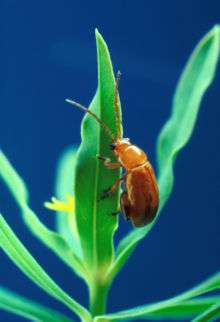Aphthona
| Aphthona | |
|---|---|
 | |
| Flea beetle Aphthona flava | |
| Scientific classification | |
| Kingdom: | Animalia |
| Phylum: | Arthropoda |
| Class: | Insecta |
| Order: | Coleoptera |
| Family: | Chrysomelidae |
| Subfamily: | Alticinae |
| Genus: | Aphthona Chevrolat, 1836[1] |
| Species | |
|
See text. | |
Aphthona is a genus of beetle, in the leaf beetle family Chrysomelidae, native to Europe and Asia. More specifically, Aphthona are flea beetles, meaning they have enlarged hind legs for jumping away from potential danger. There are 135 species known from the Palaearctic region.[2]
This flea beetle genus is important because of the usefulness of some species in controlling leafy spurge, a major invasive weed in parts of western North America. Several Aphthona species have been taken from Europe and introduced into localized areas of the United States and Canada, and some success against the weed is being seen.[3][4] The six species used for this purpose include A. abdominalis, A. cyparissiae, A. czwalinae, A. flava, A. nigriscutis, and A. lacerosa, though A. abdominalis apparently never established a viable population and was never introduced in Canada.[5][6][7]
Effectiveness of Control
Control is generally thought to be effective, but results vary from site to site, which has been attributed to soilborn pathogens, phenology of spring, soil texture, and leafy spurge density. Control is less effective in sandy soils.[8] Control may not be reliably observed and measured for 10 years or more.
Species

|
|
External links
| Wikispecies has information related to: Aphthona |
References
- ↑ Andris Bukejs. "To the knowledge of flea beetles (Coleoptera: Chrysomelidae: Alticinae) of the Latvian fauna. 4. Genus Aphthona Chevrolat, 1836" (PDF). Acta Zoologica Lituanica, 2009, Volumen 19, Numerus 3.
- ↑ Gruev, B. and Döberl, M. 1997. General Distribution of the Flea Beetles in the Palaearctic Subregion (Coleoptera, Chrysomelidae: Alticinae). Scopolia 37: 1–496.
- ↑ Hodur, N.M., Leistritz, F.L., Bangsund, D.A., 2006. Biological control of leafy spurge: utilization and implementation. Range land Ecology & Management 59, 445–452.
- ↑ Diane L. Larson; James B. Grace; Jennifer L. Larson. "Long-term dynamics of leafy spurge (Euphorbia esula) and its biocontrol agent, flea beetles in the genus Aphthona". Biological Control 47 (2008) 250–256.
- ↑ R. Roehrdanz; D. Olson; G. Fauske; R. Bourchier; A. Cortilet; S. Sears. "New DNA markers reveal presence of Aphthona species (Coleoptera: Chrysomelidae) believed to have failed to establish after release into leafy spurge" (PDF). Biological Control 49 (2009) 1–5.
- ↑ Anon (2006). "Ecology and management of leafy spurge (Euphorbia esula L.)" (PDF). United States Department of Agriculture. Natural Resources Conservation Service, Invasive Species Technical Note No. MT-2.
- ↑ Bourchier, R.S., Erb, S., McClay, A.S., Gassmann, A., 2002. Euphorbia esula (L.) leafy spurge and Euphorbia cyparissias (L.) cypress spurge (Euphorbiaceae). In: Mason, P., Huber, J. (Eds.), Biological Control Programmes Against Insect and Weeds in Canada 1981–2000. Commonwealth Agricultural Bureaux, Slough, UK, pp. 346–358.
- ↑ Laurie A. Richardson; Chelsea J. Juricek; Rodney G. Lym; Donald R. Kirby; Dwight A. Tober. "Integrated Leafy Spurge (Euphorbia esula) Control Using Imazapic, Aphthona spp. Biological Control Agents, and Seeded Native Grasses" (PDF). Invasive Plant Science and Management 2008 1:255–264.